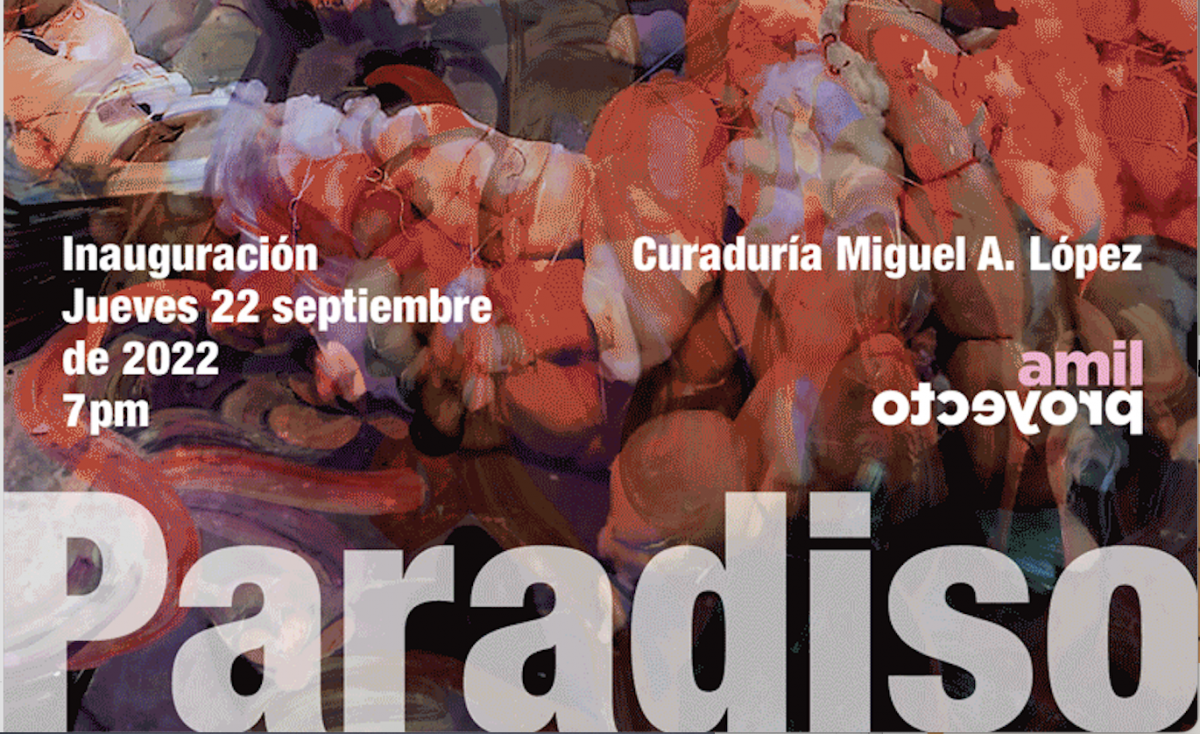
Curator Miguel A. López
▼ Download the exhibition floor plan ▼
Opening
Thursday 22 September 2022, 7pm
Exhibition Dates
23 September – 11 November 2022
Wednesday – Saturday
3pm – 8pm
proyectoamil
Lima
Letter to Enter the Underground Paradise of Mynerva and Abaddon
Dear Wynnie,
Dear María,
I write this letter in an attempt to condense the whirlwind of sensations that your works provoke in me in this underground paradise. I wonder how to make my words have a dissolving effect, just as you make all boundaries and bodily categories burn through a burst of textures and colors. Although I am addressing this letter to you, I feel that in reality, I am writing to the community of affection and complicity that cares for you and accompanies you, that lives in your saliva, in your skin, in your fantasies, in your parties, in your breathing. I perceive in these works the sweat of many shared battles. For these images to exist, you have had to survive; you have traveled and widened the paths that others opened before where there were only impenetrable walls. You are part of the same generation, you went to the same school, and you came from the same social class in a racist and elitist society. You have renounced the category of biological woman and belong to a collectivity of sexual dissidence and trans and non-binary activism that is earth-shaking. You are not what the phallocentric norm and the medical-scientific narrative proclaimed as female identities: You have redesigned your sexual organs to multiply pleasure and have introduced chemical, morphological, and hormonal variations into your flesh that collapse the architecture of modern anatomy.
In your paintings, Wynnie, the bodies rehearse ritual choreographies: as if they all came to celebrate with you the journey that allowed you to reach your anus as the sexual organ that best represents you. They are landscapes of sexual arousal, plagued by winged torsos, double penetrations, stigmas, sewn vaginas, the exhilarating and vasodilating effects of substances such as LSD or poppers, reclining bodies, bristling tongues, numerous anuses expelling feces as if it were a public ceremony and a form of dialogue with the earth, of fingernails dug into the skin. The monumentality of your pieces makes me feel that I am in front of the frescoes of a temple. Just as in the Renaissance it was thought that inside the marble there were souls waiting to be liberated, you, Wynnie, as a dissident transtemporal traveler, turn your canvases and pigments into an escape door for a grandiosity of beings that have abandoned their limits and bodily ties. Your paintings are also architecture: walls that open dark interstices in the white cube and influence our displacement. I am moved that they also commemorate your experience of surgery, transition, and escape from gender binarism since that was a journey you made in the company of Ali. Your paintings are a tribute to what sexual exploration, tenderness, and loving cooperation do in our lives.
Your sculptures, María, are glimpses of the future. Rare anatomies; exposed, stretched, pierced epidermis; pieces of flesh that flee the bony structure; vegetation and foliage that fantasize about a post-human ecology. These are also personal statements about what it means to modify your appearance in a world that punishes difference and deviation. Thus, your soft objects are a frenzy of delicacy and beauty that evoke the deep sea and sidereal landscapes. The sculptural oasis that welcomes us in the middle of the space, surrounded by your nameless creatures, seems to be the promise of an Eden for those who live a nomadic existence. You use embroidery and crochet to weave wounds, mucus, scabs, and bruises, but also countless specimens of the kingdom Fungi. The reproduction systems of fungi are the result of sexual recombination and fusion with their environment; they possess qualities of the plant and animal world without belonging to either. I see you camouflaged in that universe, escaping from the police processes of identification—of the nearly 4 million fungi, less than 150,000 have been registered by modern Western science—, claiming the trans outside of genital syntax and human morphology: a communication by electrical impulses, a filament network that plots an uprising below the ground.
The oil and cotton of your works converse, have a hallucinogenic depth, and make me forget my own body for a moment. There is much that we cannot touch with reason. This Paradiso is full of paintings and hanging fabrics, disemboweled and sewn anatomies, cocoons that are cells that are mandalas, scars, and traces of surgeries, threads that resemble melted skins, and bodily fluids as a form of spiritual communion. Freed from all laws and norms, your characters proudly carry what many consider aberrant; you invite us to open our bodies and look at the transformation of the flesh as a possibility of another life.
Miguel A. López